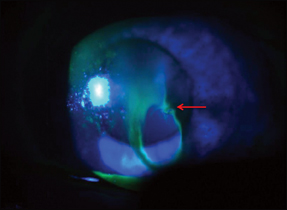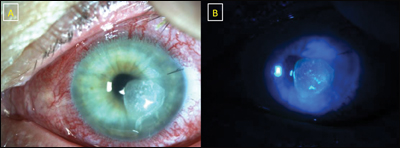Man presents 18 hours after penetrating injury to left eye
The full-thickness corneal laceration was less than 0.5 mm in diameter and was Seidel positive.
Click Here to Manage Email Alerts
A 51-year-old man with no significant ocular history presented to the Lahey Medical Center after sustaining a penetrating injury to the left eye during a home improvement project. The patient reported using a motorized wire brush to resurface a piece of sheet metal when an individual 16 mm wire broke free from the brush and penetrated his left cornea. The patient’s son immediately removed the intact wire with a pair of tweezers, and they visited a local urgent care center where he was prescribed tobramycin ointment. He was sent home with follow-up to see an ophthalmologist the next morning. The ophthalmologist then referred him to Lahey for further operative management. It had been 18 hours since the onset of injury by the time he was seen at Lahey.
Examination
At the time of presentation, best corrected visual acuity was 20/70 in the left eye. The left pupil was already pharmacologically dilated on arrival. Slit lamp exam revealed a full-thickness corneal laceration less than 0.5 mm in diameter temporal to the central visual axis. The wound was briskly Seidel positive (Figure 1). The anterior chamber was shallow relative to the right eye and had 1+ mixed pigmented and white cells. There was an opacity in the crystalline lens that appeared similar to a cortical spoke, but this opacity obscured the view of the overlying anterior capsule; it was difficult to determine whether the anterior capsule had been violated at this point, creating a traumatic cataract underneath. Posterior segment exam revealed clear vitreous without evidence of foreign body. The fundus exam was unremarkable.

Images: Constans J, Rao NK
What type of further workup would be beneficial for operative planning?
See answer on next page.
Further workup
Slit lamp photos and optical biometry were performed in each eye; preoperative measurements of the fellow eye were included to serve as a control against any potential aberrant results in the affected eye due to distortion of the anatomy. The patient was started on broad-spectrum IV antibiotics including 1 g cefazolin and 400 mg ciprofloxacin. A dose of tetanus toxoid was administered. Anterior segment OCT was then performed, confirming the disruption of the anterior lens capsule and underlying cortex (Figure 2).
The decision was made to remove the traumatic cataract and close the corneal laceration but to leave the patient aphakic with a plan to stage IOL placement as a secondary procedure. This was based on concern for the development of postoperative infection; there was a significant amount of time that had elapsed between the injury and initiation of appropriate antimicrobial therapy. The risks, benefits and alternatives to surgical intervention were discussed with the patient and his family. He elected to proceed and was taken to the operating room.
Operative technique
Initial inspection under the operating microscope confirmed the presence of a central corneal perforation. The cornea remained otherwise clear with good visualization of the lens. The anterior capsule had a mid-peripheral rupture that extended superotemporally toward the 2 o’clock meridian. A paracentesis incision was created inferotemporally, and a cohesive ophthalmic viscosurgical device was instilled into the anterior chamber. A temporal triplanar 2.75-mm limbal incision was created, and four iris hooks were inserted through paracentesis sites to improve visualization of the radial extent of the anterior capsule tear. Trypan blue was used to stain the anterior capsule tear. Intraocular microforceps and microscissors were then used to convert the tear into an eccentric continuous curvilinear capsulorrhexis by incorporating the tear in its entirety.

Gentle hydrodissection and hydrodelineation were performed, with care to limit excess stress on the capsular bag and zonules. The nucleus, epinucleus and cortex were removed without complication via low-flow phacoemulsification and irrigation/aspiration. The posterior capsule was closely inspected and found to be intact. The four iris hooks were removed without complication. Attention was then directed to the corneal perforation. Additional cohesive OVD was instilled into the anterior chamber, tamponading the leak. This provided a dry external corneal surface, upon which a thin layer of cyanoacrylate glue was applied and allowed to polymerize. The viscoelastic agent was removed from the anterior chamber by irrigation/aspiration, and a suture was placed to close the temporal corneal incision. All paracentesis sites were sealed by stromal hydration, and a fluorescein strip was used to verify that all incisions and the corneal perforation site were Seidel negative. A bandage contact lens was placed for comfort.
Literature review of imaging and operative considerations
With an incidence of roughly 200,000 cases per year worldwide, open-globe injuries represent a source of significant ocular morbidity, often requiring urgent surgical intervention. Roughly 30% of those cases involving perforating injury to the anterior chamber also involve damage to the lens with formation of a traumatic cataract. Resultant zonular weakness or loss of capsular integrity often complicates repair efforts, necessitating careful investigation and preoperative planning.
Perry investigated the beneficial role of ultrasonography in the preoperative assessment of these patients, particularly when the view of the posterior segment was obscured by corneal edema, cataract or hemorrhage. The author advocated for the use of B-scans, given their greater depth of penetration, in cases with potential involvement of the posterior capsule due to a 93% sensitivity and 86% specificity for identifying posterior capsule rupture. The author further described the use of ultrasound biomicroscopy in anterior segment evaluation, discussing its particular utility in determining zonular integrity and identifying retained foreign bodies. Finally, the author outlined the use of anterior segment OCT imaging in the evaluation of the lens capsule, particularly among the pediatric population given its lack of ocular contact and reduced need for cooperation.
Two issues faced by surgeons when evaluating a traumatic cataract are whether to remove the cataract and whether to insert an IOL at the time of the initial surgery. With regard to primary vs. staged lensectomy, the literature advocates for removal at the time of primary repair in cases in which the capsule has been violated. This is based primarily on the intense inflammatory reaction and risk of ensuing sequelae (synechiae, fibrinous uveitis, elevated IOP) seen after exposure of the eye to the previously sequestered lenticular proteins. If the capsule is intact with no tear or rupture, the traumatic cataract may be observed and removed only when it becomes visually significant.
The second decision between primary vs. staged IOL placement after removing the cataract in these cases remains controversial. This is due to a lack of prospective data within the current body of literature comparing the two methods. Proponents of primary IOL placement cite factors including shortened rehabilitation time, reduction in the number of surgical/anesthetic procedures, and the potential for a technically easier surgical case given the lack of inflammatory changes. Those advocating for a staged secondary IOL placement voice concern that the IOL could act as a nidus for infection and could lead to increased postoperative inflammation and elevated IOP. Secondary IOL placement could also allow for more accurate determination of axial length, keratometry and anterior chamber depth once postoperative swelling resolves, leading to more accurate IOL calculations. The literature, however, remains sparse, and further investigation is warranted.
Rumelt and colleague performed a retrospective review of 69 eyes with traumatic cataract, 45 of which had concomitant open-globe injury. They found no statistically significant difference in best corrected vision when an IOL was implanted primarily or secondarily. Shah and colleague performed a meta-analysis of multiple retrospective studies assessing primary vs. secondary IOL placement. They concluded that while both options improved visual acuity with minimal complications, primary IOL placement at the time of initial repair may result in a better final acuity and binocular function. One caveat mentioned in favor of secondary IOL placement was that astigmatism could be better accounted for by delayed biometry once postoperative inflammation resolved, as opposed to estimating the keratometry of the affected eye by using the values from the fellow eye at the time of primary repair. The authors found that the arguments against primary IOL placement with respect to postoperative inflammation and IOP elevation were not supported by the data and proposed that primary IOL implantation may be of higher importance in the pediatric population due to concern for the development of aphakia-induced deprivation amblyopia. Finally, although eyes with obvious infection at initial presentation were excluded from most studies within the review, there was a notable paucity of data regarding postoperative infection rates in both primary and secondary IOL placement, with the exception of a single case report of endophthalmitis following primary IOL placement.

Follow-up
The patient was evaluated 1 week after the surgery (Figure 3). His vision was count fingers at 3 feet. The corneal glue was intact over the laceration without evidence of leaking underneath. IOP was stable at 15 mm Hg with a deep and quiet anterior chamber. The posterior capsule remained intact, and there were no signs of infection. The patient was continued on a regimen of prednisolone and gatifloxacin ophthalmic drops. He will continue to be followed closely. The plan is to return to the OR in 4 to 6 weeks for placement of a secondary IOL in the capsular bag or in the sulcus.
- References:
- Agarwal A, et al. Curr Opin Ophthalmol. 2010;doi:10.1097/ICU.0b013e3283331579.
- Perry LJ. Semin Ophthalmol. 2012;doi:10.3109/08820538.2012.712733.
- Rumelt S, et al. Graefes Arch Clin Exp Ophthalmol. 2010;doi:10.1007/s00417-010-1378-x.
- Section 11: Lens and cataract. In: Bobrow JC, ed. 2015-2016 Basic and Clinical Science Course (BCSC). American Academy of Ophthalmology; 2015.
- Shah M, et al. Can J Ophthalmol. 2013;doi:10.1016/j.jcjo.2013.03.010.
- Shah AS, et al. Int Ophthalmol Clin. 2010;doi:10.1097/IIO.0b013e3181c56874.
- For more information:
- James Constans, MD, and Naveen K. Rao, MD, can be reached at New England Eye Center, Tufts University School of Medicine, 750 Washington St., Box 450, Boston, MA 02111; website: www.neec.com.
- Edited by Jessica Moon, MD, and Emily C. Wright, MD. They can be reached at the New England Eye Center, Tufts University School of Medicine, 750 Washington St., Box 450, Boston, MA 02111; website: www.neec.com.
